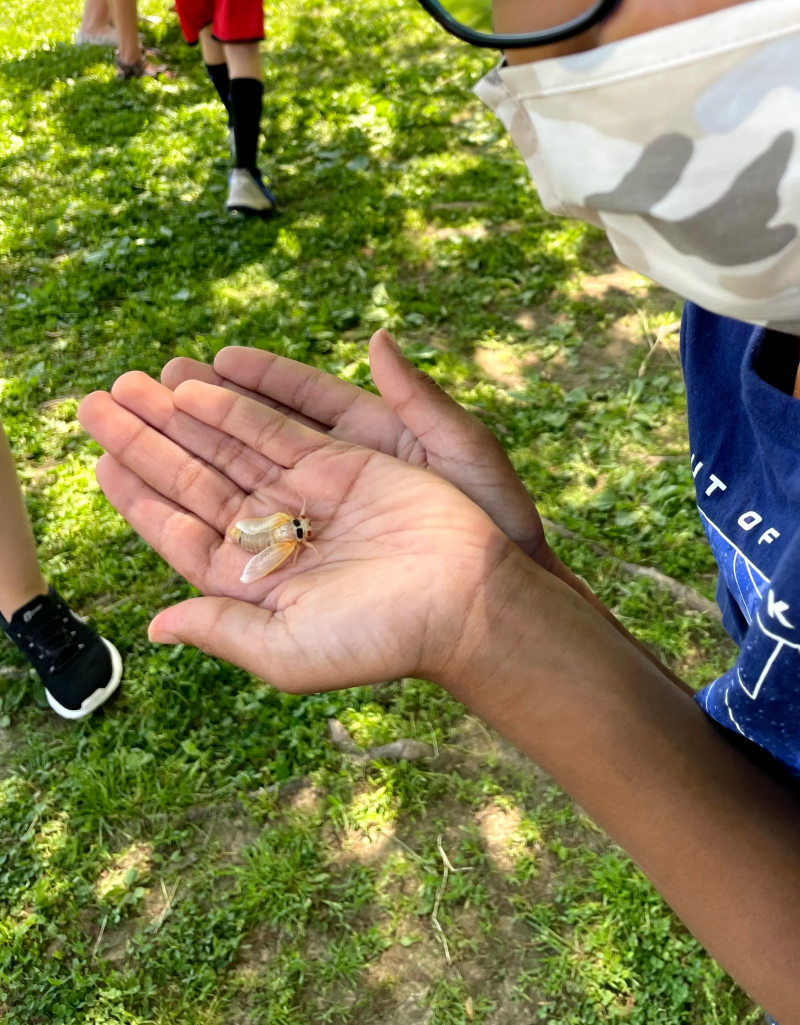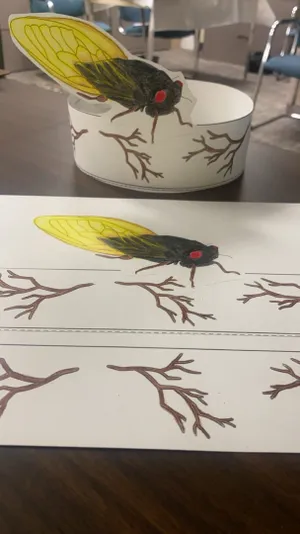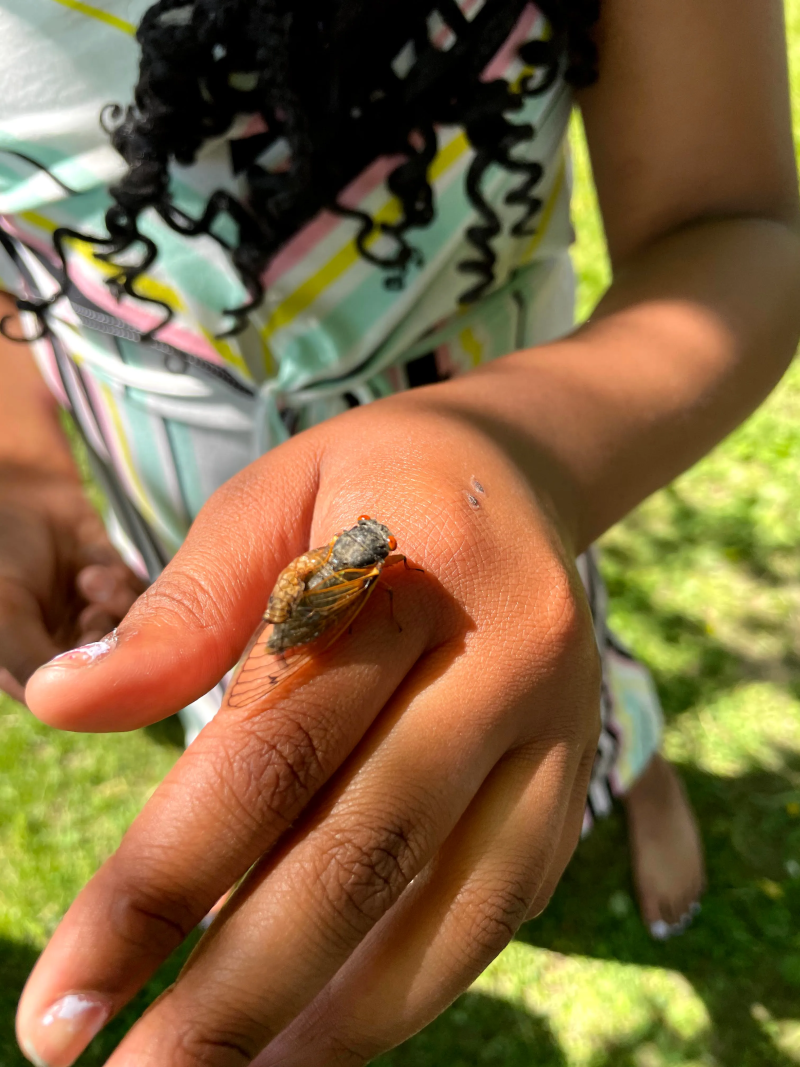Kids often fear 'ugly and creepy' cicadas. Teachers know how to change their minds.
Cicadas have emerged from the ground, like billions of thundering time-travelers. And America's teachers say they bring important lessons with them.
Some of those lessons are unsurprising — in some classrooms they'll be be fodder for word problems, spelling tests and dioramas.
“You can teach everything with them. Roman numerals, maps, charts, nutrition lifecycle, even English,” said Nancy Murtaugh, a Fairfield, Ohio teacher who spent a full month on a cicada project with her fourth graders.
But Murtaugh and other teachers say the cicadas also bring with them profound truths.
Knowledge dispels fear. Time is precious and moves quickly. Social media keeps reshaping society.

The emergence is the perfect time to get today's youth to go outside and experience something awesome, said Nancy Kuhajda, a science educator with the University of Illinois Extension program.
Periodical cicadas offer a tremendous teaching opportunity and teachers across the country have created lesson plans around them. The National Museum of Natural History in Washington D.C. has also created teaching materials for every age.
What are all those noisy bugs?Cicadas explained for kids with printable coloring activity
“We see a huge change within a very short time where children engage in nature because its, well, it’s natural.”
Knowledge dispels fear
Facts can transform a classroom of fearful, worried children into intrepid naturalists.
They become excited to see the skin split over newly emerged cicadas and the bulging red eyes and orange-tinged wings of mature ones covering every tree trunk. Some kids are even giddy when the insects finally begin flying and land on them.
"When you learn the facts and become educated about cicadas, you realize they are cool, not scary, said Murtaugh.
Cicadas and fear:Hordes of thunderous, harmless cicadas are coming. It's normal to feel a little dread.
But students usually don't start out that way. "At first the kids were really scared," she said. "Others said the cicadas were ugly and creepy."
That changed as she took her fourth-grade class through a solid month of lessons that touched on all things cicada when they emerged in her area in 2021, her students' fear abated and was replaced with wonder.
"Studying them and learning about them totally changed how our students thought about cicadas," said Murtaugh, who has 27 years of teaching experience. "They weren’t scared of them, they didn’t want to harm them, they were really engaged. They started to welcome it when the bugs landed on them. They’d say 'Ms. Murtaugh, I‘ve got a cicada!'”

For Andrea Auerbach in Falls Church, Virginia, the emergence of Brood X in 2021 was a chance to let the students of Belvedere Elementary School get up close and personal with something rare and amazing – in a way she herself didn’t when they emerged in 2004, the first one she remembers.
“I had the experience of not particularly liking them or wanting to be outside when the cicadas were out,” the environmental education teacher said.
“I wanted to try to give a different experience to my students.” It worked. She’s not only learned to embrace, or at least hold, cicadas herself but her students were very enthusiastic when Brood X emerged three years ago.
The memories are indelible. Today’s fourth and fifth graders haven’t forgotten the lessons they learned back in first grade “I have a container of exoskeletons in my space and every now and then students see them and say, ‘I remember those!’”

Time is precious and moves quickly
“We wrote letters to our first graders and told them about the cicadas so they wouldn’t be afraid,” she said. Four years after the 2021 emergence, those first graders are now her fourth graders and they haven't forgotten what they learned.
"They remember the letters our fourth-grade class wrote," she said.
Such moments that reach across time are especially weighted. “Brood X are 17-year cicadas. I told my students, ‘You’ll be 27 the next time these bugs come out’ and it blew their minds,” she said.
For Kuhajda, the cicada emergence can be a “cosmic moment” for young people, especially now when so many kids spend so little time outside.
Cicadas and your garden:Cicadas will soon become a massive, dead and stinky mess. There's a silver lining.
“It’s stirring. When we talked about the solar eclipse, we said it wouldn’t come for another 20 years. For cicadas, it’s 17 years. There is something extremely powerful about these long-term natural events,” she said.
Based in the old steel town of Joliet surrounded by a very rural agricultural area, Kuhajda has been teaching grade school students about the broods that will be emerging in their area for weeks.
“There’s no other nature opportunity like this,” she said.
That’s especially true in Will County, where she lives.
“We have the cataclysmic trifecta,” she said. “We have all three broods coming out at the same time. There’s always the annual cicadas, what we call the dog day cicadas, and then both Broods XIX and XIII, all coming out together. So as many as you can have, we have.”
Social media keeps reshaping society
In Illinois, Kuhajda has been teaching the public about nature for 30 years and she’s seen an enormous, and sad, change in how people — especially the young people she works with — engage with the world.
“When I was a child, parents weren’t alarmed. It was pre fear of everything germy. We were just outside.”
Things were even different in 2007. “The last time this happened in our area, there was no social media,” she said. Children spent more time outside and were more connected to the natural world.
“Today, kids don’t want to be outside if it’s too hot or too cold or too wet or too dry,” she said. Instead, they’ll spend hours on TikTok and Instagram watching 30-second videos about cicadas.
The emergence is the perfect time to get them to actually go outside and experience something awesome.
“Nature teaches in ways that we don’t even understand at the time,” she said. “Nature is slow learning.”
Teaching children also helps some of the information get back to their families, who often have been exposed to misinformation on social media, said Kuhajda. She works with schools, youth groups and Boy and Girl Scout troops to teach about nature.
In some ways, it's refreshing to work with children because they don't come with so many preconceived misconceptions about the emergence of periodical cicadas, she said.
"When you talk to a child about an insect, the first thing they ask is, 'Does it bite or does it sting? And the answer is no.'" she said. Once they know that, they can open up to the amazing natural phenomenon that the cicadas are.
"There’s an urgency to help children understand nature sooner rather than later because there’s so many other types of information they're being exposed to that appears true to a child," she said. "If a child has been on TikTok for hours seeing every scary or untrue thing about cicadas, we have a lot of work to do."
Disclaimer: The copyright of this article belongs to the original author. Reposting this article is solely for the purpose of information dissemination and does not constitute any investment advice. If there is any infringement, please contact us immediately. We will make corrections or deletions as necessary. Thank you.



